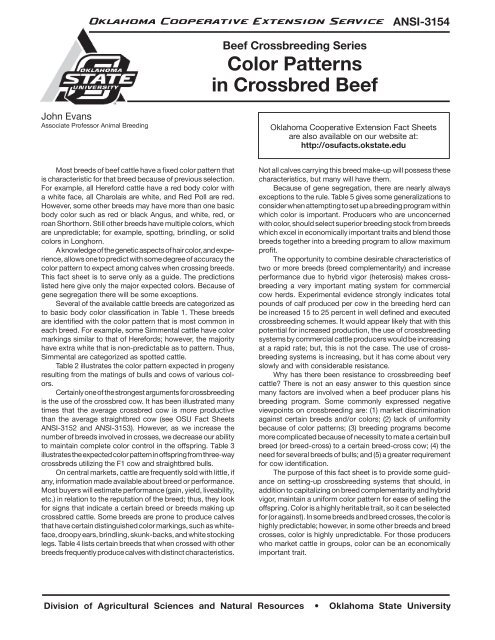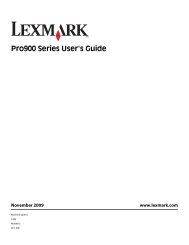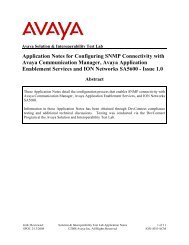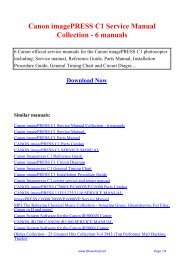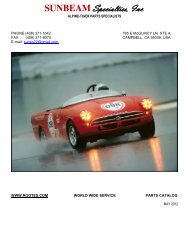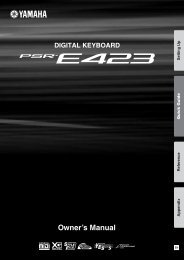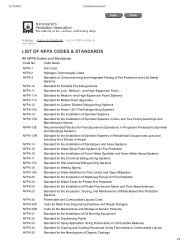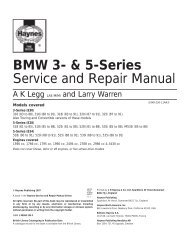Color Patterns in Crossbred Beef - OSU Fact Sheets - Oklahoma ...
Color Patterns in Crossbred Beef - OSU Fact Sheets - Oklahoma ...
Color Patterns in Crossbred Beef - OSU Fact Sheets - Oklahoma ...
Create successful ePaper yourself
Turn your PDF publications into a flip-book with our unique Google optimized e-Paper software.
<strong>Oklahoma</strong> Cooperative Extension Service<br />
John Evans<br />
Associate Professor Animal Breed<strong>in</strong>g<br />
Most breeds of beef cattle have a fixed color pattern that<br />
is characteristic for that breed because of previous selection.<br />
For example, all Hereford cattle have a red body color with<br />
a white face, all Charolais are white, and Red Poll are red.<br />
However, some other breeds may have more than one basic<br />
body color such as red or black Angus, and white, red, or<br />
roan Shorthorn. Still other breeds have multiple colors, which<br />
are unpredictable; for example, spott<strong>in</strong>g, br<strong>in</strong>dl<strong>in</strong>g, or solid<br />
colors <strong>in</strong> Longhorn.<br />
Aknowledgeofthegeneticaspectsofhaircolor,andexperience,<br />
allows one to predict with some degree of accuracy the<br />
color pattern to expect among calves when cross<strong>in</strong>g breeds.<br />
This fact sheet is to serve only as a guide. The predictions<br />
listed here give only the major expected colors. Because of<br />
gene segregation there will be some exceptions.<br />
Several of the available cattle breeds are categorized as<br />
to basic body color classification <strong>in</strong> Table 1. These breeds<br />
are identified with the color pattern that is most common <strong>in</strong><br />
each breed. For example, some Simmental cattle have color<br />
mark<strong>in</strong>gs similar to that of Herefords; however, the majority<br />
have extra white that is non-predictable as to pattern. Thus,<br />
Simmental are categorized as spotted cattle.<br />
Table 2 illustrates the color pattern expected <strong>in</strong> progeny<br />
result<strong>in</strong>g from the mat<strong>in</strong>gs of bulls and cows of various colors.<br />
Certa<strong>in</strong>lyoneofthestrongestargumentsforcrossbreed<strong>in</strong>g<br />
is the use of the crossbred cow. It has been illustrated many<br />
times that the average crossbred cow is more productive<br />
than the average straightbred cow (see <strong>OSU</strong> <strong>Fact</strong> <strong>Sheets</strong><br />
ANSI-3152 and ANSI-3153). However, as we <strong>in</strong>crease the<br />
number of breeds <strong>in</strong>volved <strong>in</strong> crosses, we decrease our ability<br />
to ma<strong>in</strong>ta<strong>in</strong> complete color control <strong>in</strong> the offspr<strong>in</strong>g. Table 3<br />
illustratestheexpectedcolorpattern<strong>in</strong>offspr<strong>in</strong>gfromthree-way<br />
crossbreds utiliz<strong>in</strong>g the F1 cow and straightbred bulls.<br />
On central markets, cattle are frequently sold with little, if<br />
any, <strong>in</strong>formation made available about breed or performance.<br />
Most buyers will estimate performance (ga<strong>in</strong>, yield, liveability,<br />
etc.) <strong>in</strong> relation to the reputation of the breed; thus, they look<br />
for signs that <strong>in</strong>dicate a certa<strong>in</strong> breed or breeds mak<strong>in</strong>g up<br />
crossbred cattle. Some breeds are prone to produce calves<br />
that have certa<strong>in</strong> dist<strong>in</strong>guished color mark<strong>in</strong>gs, such as whiteface,<br />
droopy ears, br<strong>in</strong>dl<strong>in</strong>g, skunk-backs, and white stock<strong>in</strong>g<br />
legs. Table 4 lists certa<strong>in</strong> breeds that when crossed with other<br />
breeds frequently produce calves with dist<strong>in</strong>ct characteristics.<br />
<strong>Beef</strong> Crossbreed<strong>in</strong>g Series<br />
<strong>Color</strong> <strong>Patterns</strong><br />
<strong>in</strong> <strong>Crossbred</strong> <strong>Beef</strong><br />
ANSI-3154<br />
<strong>Oklahoma</strong> Cooperative Extension <strong>Fact</strong> <strong>Sheets</strong><br />
are also available on our website at:<br />
http://osufacts.okstate.edu<br />
Not all calves carry<strong>in</strong>g this breed make-up will possess these<br />
characteristics, but many will have them.<br />
Because of gene segregation, there are nearly always<br />
exceptions to the rule. Table 5 gives some generalizations to<br />
consider when attempt<strong>in</strong>g to set up a breed<strong>in</strong>g program with<strong>in</strong><br />
which color is important. Producers who are unconcerned<br />
with color, should select superior breed<strong>in</strong>g stock from breeds<br />
which excel <strong>in</strong> economically important traits and blend those<br />
breeds together <strong>in</strong>to a breed<strong>in</strong>g program to allow maximum<br />
profit.<br />
The opportunity to comb<strong>in</strong>e desirable characteristics of<br />
two or more breeds (breed complementarity) and <strong>in</strong>crease<br />
performance due to hybrid vigor (heterosis) makes crossbreed<strong>in</strong>g<br />
a very important mat<strong>in</strong>g system for commercial<br />
cow herds. Experimental evidence strongly <strong>in</strong>dicates total<br />
pounds of calf produced per cow <strong>in</strong> the breed<strong>in</strong>g herd can<br />
be <strong>in</strong>creased 15 to 25 percent <strong>in</strong> well def<strong>in</strong>ed and executed<br />
crossbreed<strong>in</strong>g schemes. It would appear likely that with this<br />
potential for <strong>in</strong>creased production, the use of crossbreed<strong>in</strong>g<br />
systems by commercial cattle producers would be <strong>in</strong>creas<strong>in</strong>g<br />
at a rapid rate; but, this is not the case. The use of crossbreed<strong>in</strong>g<br />
systems is <strong>in</strong>creas<strong>in</strong>g, but it has come about very<br />
slowly and with considerable resistance.<br />
Why has there been resistance to crossbreed<strong>in</strong>g beef<br />
cattle? There is not an easy answer to this question s<strong>in</strong>ce<br />
many factors are <strong>in</strong>volved when a beef producer plans his<br />
breed<strong>in</strong>g program. Some commonly expressed negative<br />
viewpo<strong>in</strong>ts on crossbreed<strong>in</strong>g are: (1) market discrim<strong>in</strong>ation<br />
aga<strong>in</strong>st certa<strong>in</strong> breeds and/or colors; (2) lack of uniformity<br />
because of color patterns; (3) breed<strong>in</strong>g programs become<br />
more complicated because of necessity to mate a certa<strong>in</strong> bull<br />
breed (or breed-cross) to a certa<strong>in</strong> breed-cross cow; (4) the<br />
need for several breeds of bulls; and (5) a greater requirement<br />
for cow identification.<br />
The purpose of this fact sheet is to provide some guidance<br />
on sett<strong>in</strong>g-up crossbreed<strong>in</strong>g systems that should, <strong>in</strong><br />
addition to capitaliz<strong>in</strong>g on breed complementarity and hybrid<br />
vigor, ma<strong>in</strong>ta<strong>in</strong> a uniform color pattern for ease of sell<strong>in</strong>g the<br />
offspr<strong>in</strong>g. <strong>Color</strong> is a highly heritable trait, so it can be selected<br />
for (or aga<strong>in</strong>st). In some breeds and breed crosses, the color is<br />
highly predictable; however, <strong>in</strong> some other breeds and breed<br />
crosses, color is highly unpredictable. For those producers<br />
who market cattle <strong>in</strong> groups, color can be an economically<br />
important trait.<br />
Division of Agricultural Sciences and Natural Resources • <strong>Oklahoma</strong> State University
Table 1. Basic body colors of cattle and the breeds identified with those colors<br />
White Light hair color with Mixed<br />
Black Red or Cream dark pigment sk<strong>in</strong>s Spotted colors<br />
Angus Barzona Shorthorn Brahman <strong>Beef</strong> Friesian <strong>Beef</strong>master<br />
Brangus Devon Charolais Brown Swiss Hays Converter Braford<br />
Ank<strong>in</strong>a Gelbvieh White Park Chian<strong>in</strong>a Holste<strong>in</strong> Longhorn<br />
Galloway Herford Blonde'd Marchigiana Ma<strong>in</strong>e Anjou<br />
Welch Black Polled Hereford Aquita<strong>in</strong>e Murray Grey Normande<br />
Limous<strong>in</strong> Romagnola MRI<br />
L<strong>in</strong>coln Red Jersey P<strong>in</strong>zqauer<br />
Norwegian Red Tarentaise Simmental<br />
Red Angus<br />
Red Poll<br />
Salers<br />
Santa Gertrudis<br />
Scotch Highland<br />
Shorthorn<br />
South Devon<br />
Table 2. Expected color patterns when cross<strong>in</strong>g breeds of various colors<br />
Black<br />
Red<br />
White<br />
Light hair<br />
with dark sk<strong>in</strong><br />
Spotted<br />
No fixed color<br />
Black<br />
Light hair Mixed<br />
Black Red White with dark sk<strong>in</strong> Spotted colors<br />
Black<br />
Black-smokey Blacksome<br />
br<strong>in</strong>dl<strong>in</strong>g<br />
Black-few spots Black Mostly Black<br />
Red<br />
Red-roan<br />
White<br />
3154-2<br />
Redsome<br />
br<strong>in</strong>dl<strong>in</strong>g<br />
White-Grey<br />
Grey<br />
Red- or Blacksome<br />
spots<br />
Most spottedsome<br />
white<br />
Grey-some spotted<br />
Spotted<br />
Some Redmostly<br />
mixed<br />
Mixed<br />
Mixed<br />
Mixed<br />
Mixed
Table 3. Expected offspr<strong>in</strong>g color patterns (from a three-way cross us<strong>in</strong>g the F1 cow)<br />
Black x Black<br />
x Red<br />
x White<br />
x Spot<br />
x Mixed<br />
Red x White<br />
x Spot<br />
x Mixed<br />
White x White<br />
x Spot<br />
x White<br />
Spot x Spot<br />
x Mixed<br />
Mixed x Mixed<br />
Black<br />
Black<br />
Black<br />
Black<br />
Black<br />
Black<br />
Mostly Black<br />
Mostly Black<br />
Diluted Black<br />
Mostly Black<br />
Mostly Black<br />
Black Red White Spot Mixed<br />
Spots-mostly black<br />
Spots-mostly black<br />
Br<strong>in</strong>dl<strong>in</strong>g-mostly black<br />
Black<br />
Black & Red<br />
Black & Red<br />
Black & Red & Spots<br />
Black & Mixed<br />
Mostly Red<br />
Mostly Red<br />
Mostly Red<br />
Red-roan<br />
Red-spot<br />
Mixed<br />
Red-spot<br />
Spot-mixed<br />
Mixed<br />
3154-3<br />
Mostly Black<br />
Black & Red<br />
Black-smokey<br />
Black-mixed<br />
Black-mixed<br />
Mixed<br />
Mixed<br />
Mixed<br />
White<br />
White-spot<br />
Mixed<br />
Spot<br />
Spot<br />
Mixed<br />
Mostly Black<br />
Variable<br />
Black-mixed<br />
Black & Spots<br />
Mixed<br />
Mixed<br />
Mostly Spots<br />
Mixed<br />
Spots-white<br />
Spots-mixed<br />
Mixed<br />
Spot<br />
Spot<br />
Mixed<br />
Mostly Black<br />
Mixed<br />
Mixed<br />
Mixed<br />
Mixed<br />
Mixed<br />
Mixed<br />
Mixed<br />
Mixed<br />
Mixed<br />
Mixed<br />
Mixed<br />
Mixed<br />
Table 4. Breeds which commonly leave specific color mark<strong>in</strong>gs suggest<strong>in</strong>g their presence <strong>in</strong> crossbred calves<br />
White-face Br<strong>in</strong>dl<strong>in</strong>g Skunk-backs Stock<strong>in</strong>g legs Droopy ear and navel<br />
Hereford<br />
Polled Hereford<br />
Simmental<br />
Jersey<br />
Brown Swiss<br />
Brahman<br />
Chiania<br />
Tarentaise<br />
Longhorn<br />
Charolais<br />
P<strong>in</strong>zqauer<br />
Holste<strong>in</strong><br />
<strong>Beef</strong> Friesian<br />
Ma<strong>in</strong>e Anjou<br />
Simmental<br />
Hays Converter<br />
Hereford<br />
Polled Hereford<br />
Mixed<br />
Brahman<br />
Brangus<br />
Santa Gertrudis<br />
Braford
Table 5. Generalizations to remember if try<strong>in</strong>g to create a certa<strong>in</strong> color pattern.<br />
Th<strong>in</strong>gs to do:<br />
1. Want to create a black baldy?<br />
a) Infusion of Hereford (H or P) will put white or brockle face on essentially any color of cow.<br />
b) Infusion of Simmental will put striped or blazed face on solid colored cows but white face on white faced cows (i.e.<br />
Hereford or baldy cows)<br />
c) Black is dom<strong>in</strong>ant to red color <strong>in</strong> cattle. Thus the first cross between black and red will produce essentially all black<br />
(depends upon frequency of black cows or bulls that are red carriers) calves. If the second cross is to a red bull the<br />
color of calves will be 1/2 black:1/2 red, but by us<strong>in</strong>g a black bull the calves will aga<strong>in</strong> be essentially all black.<br />
d) Breed examples<br />
Angus Hereford<br />
Brangus X (H or P) → Black baldy calf<br />
Galloway Simmental<br />
2. Only want one body color from three-breed cross program?<br />
a) If red is desired, producer must use only red breeds.<br />
b) If black is desired producer must use only black breeds.<br />
c) A mixture of red and black breeds will produce black offspr<strong>in</strong>g the first cross but a mixture of red and black (close to<br />
50-50) <strong>in</strong> second and third crosses.<br />
3. <strong>Color</strong> not important?<br />
a) Use any breed, just concentrate on blend<strong>in</strong>g breeds for production traits such as milk production, fertility, growth,<br />
etc.<br />
<strong>Oklahoma</strong> State University, <strong>in</strong> compliance with Title VI and VII of the Civil Rights Act of 1964, Executive Order 11246 as amended, Title IX of the Education Amendments of 1972, Americans<br />
with Disabilities Act of 1990, and other federal laws and regulations, does not discrim<strong>in</strong>ate on the basis of race, color, national orig<strong>in</strong>, gender, age, religion, disability, or status as a veteran <strong>in</strong><br />
any of its policies, practices, or procedures. This <strong>in</strong>cludes but is not limited to admissions, employment, f<strong>in</strong>ancial aid, and educational services.<br />
Issued <strong>in</strong> furtherance of Cooperative Extension work, acts of May 8 and June 30, 1914, <strong>in</strong> cooperation with the U.S. Department of Agriculture, Robert E. Whitson, Director of Cooperative<br />
Extension Service, <strong>Oklahoma</strong> State University, Stillwater, <strong>Oklahoma</strong>. This publication is pr<strong>in</strong>ted and issued by <strong>Oklahoma</strong> State University as authorized by the Vice President, Dean, and Director<br />
of the Division of Agricultural Sciences and Natural Resources and has been prepared and distributed at a cost of 20 cents per copy. 0604<br />
3154-4


